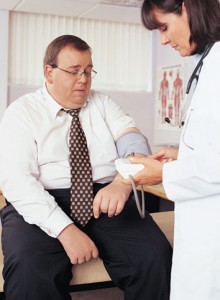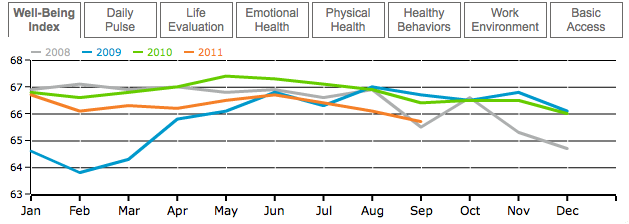Are We Really Losing 1% of GDP Due to Poor Health? Also, a Poll on Polling

(Digital Vision)
We’ve been writing a lot about obesity recently. First, it was this study about projected future obesity rates, then we covered Denmark’s saturated fat tax, which Steve Sexton then criticized for being inefficient. So, if you’re tired of reading fat-related posts on our blog, I get it. But as long as reports like this one from Gallup keep coming out, we’re going to keep writing about them, especially when they include so many interesting conversation points.
Here are the top-line numbers:
About 86% of full-time American workers are above normal weight or have at least one chronic condition. These workers miss a combined estimate of 450 million more days of work each year than their healthy counterparts, resulting in an estimated cost of more than $153 billion in lost productivity per year. That’s roughly 1% of GDP.
Respondents were asked the question: “During the past 30 days, for about how many days did poor health keep you from doing your usual activities?” Here’s a sample of the responses:
- 13.9% reported being normal weight and not having chronic conditions. They reported an average of .34 unhealthy days per month.
- 30.2% reported being overweight or obese, as and having one to two chronic conditions. They reported an average of 1.08 unhealthy days per month.
- 17.8% reported being overweight or obese and having three or more chronic conditions. They reported an average of 3.51 unhealthy days per month.
The data comes from Gallup’s Well-Being Index, which interviews at least 1,000 U.S. adults every day, and asks them questions pertaining to their health to keep a real-time measurement of our overall “well-being.” The result is this chart showing self-reported well-being scores over the last four years.

Though we started out 2011 all right, our well-being has been on the decline since about June, roughly the peak of the stock market before its latest swoon. In terms of the survey data, check out the fine print on Gallup’s interview methodology:
Results are based on telephone interviews conducted as part of the Gallup-Healthways Well-Being Index survey Jan. 2-Oct. 2, 2011, with a random sample of 270,695 adults, aged 18 and older, living in all 50 U.S. states and the District of Columbia, selected using random-digit-dial sampling. Of these, 109,875 were employed full-time at the time of the interview and they provided height and weight data to calculate body mass index scores.
Yikes, that’s only a 40% full-time employment rate for the initial sample of people who actually answered the phone. Even the most ghastly under-employment stats showing the rates of underemployed (those working part-time who want to work full-time) aren’t anywhere near that high. There’s more:
Each sample includes a minimum quota of 400 cell phone respondents and 600 land-line respondents per 1,000 national adults, with additional minimum quotas among land line respondents by region.
As The Economist pointed out last year, there’s reason to believe we’ve entered a “dark age” of polling recently, since it’s gotten so much harder to track people down. Calls to people’s land-line no longer capture a broad enough sample, since roughly a quarter of Americans are now cell-phone only. Not only is it more expensive to poll people by cell phone, it’s also not as effective, since “cell-phone onlys” (polling industry jargon) are less likely to take part in a poll.
Just how accurate a measure is this? Gallup appears to have more than compensated for the “cell-phone onlys” by using a 40% cell-phone polling baseline. But are the people taking these calls somehow more likely to be unhealthy and to have missed work? Were they perhaps on a sick day when they answered the phone? Think about it: How often do you answer a call on your cell phone from an unknown number while at work? Come to think of it, just out of curiosity, I’d be interested to know how many readers have received a call from a polling firm. So how about a poll:
[poll id=”21″]

Comments